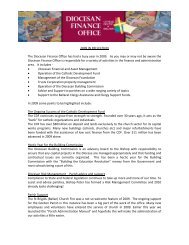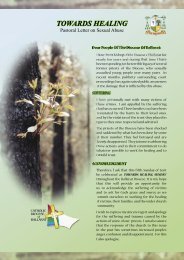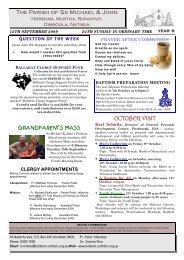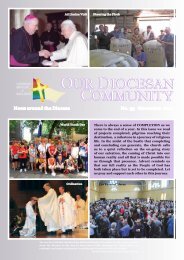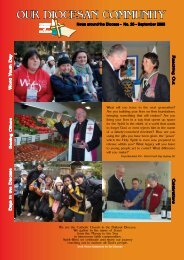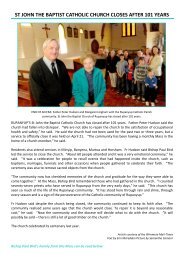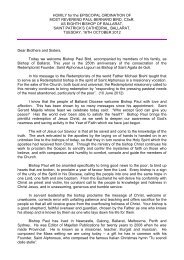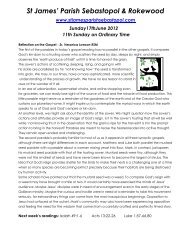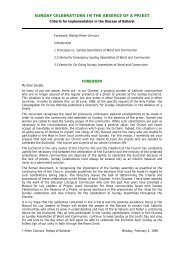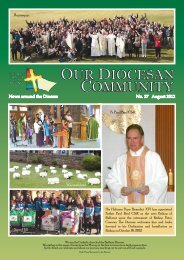our diocesan community - Catholic Diocese of Ballarat - Australian ...
our diocesan community - Catholic Diocese of Ballarat - Australian ...
our diocesan community - Catholic Diocese of Ballarat - Australian ...
- No tags were found...
You also want an ePaper? Increase the reach of your titles
YUMPU automatically turns print PDFs into web optimized ePapers that Google loves.
When I was appointed Bishop <strong>of</strong> <strong>Ballarat</strong> twelve years ago, I was required to choose a motto for my Crest to be used for<strong>of</strong>ficial documentation. By an act <strong>of</strong> God’s providence I decided upon “That we may be one”. I saw it as a response to theprayer <strong>of</strong> Jesus at the Last Supper, when he prayed that his disciples might “be one as you Father are in me and I am inyou. May they be one in us; so that the world may believe that you have sent me” (John 17: 21).A few years previously in May 1995, Pope John Paul II had published an Encyclical Letter “On Commitment to Ecumenism”which he introduced with the same theme: “That they may be one”. One <strong>of</strong> my first duties was to sign a covenant forgreater co-operation between the Anglican and the <strong>Catholic</strong> <strong>Diocese</strong>s <strong>of</strong> <strong>Ballarat</strong>.My close association with the late Archbishop Frank Little over many years, prompted me to reflect on the importance <strong>of</strong>unity among all Christians if we are to give true witness to Jesus Christ. Archbishop Little was renowned for hiscommitment to the cause <strong>of</strong> Christian Unity.Our whole nation felt relieved and involved when Prime Minister Kevin Rudd said “Sorry” to <strong>our</strong> indigenous brothers andsisters, in Federal Parliament in February 2008. It was an important step along the road to true reconciliation, with thosewho have suffered so much over the past two hundred years.On several occasions I have expressed my sincere regret and apology for the suffering and trauma caused by the actions<strong>of</strong> some <strong>of</strong> <strong>our</strong> priests. I know that this will be for the survivors but one step upon the road towards healing, and perhapsone day being reconciled with the Church.Because we are human and capable <strong>of</strong> sin, reconciliation is at the heart <strong>of</strong> life’s business. We recall the many occasionswhen Jesus dealt with the issue <strong>of</strong> forgiveness and <strong>of</strong> the need to be reconciled with <strong>our</strong> sisters and brothers before we canapproach God (cf. Matthew 18: 21 -22; Luke 17:33-34). The final prayer <strong>of</strong> Jesus on the Cross was for the forgiveness <strong>of</strong>his executioners (cf. Luke 23:34).The parable <strong>of</strong> the Prodigal Son is above all the story <strong>of</strong> the inexpressible love <strong>of</strong> a Father – God – who <strong>of</strong>fers to his sonwhen he comes back to him, the gift <strong>of</strong> full reconciliation. The elder son portrays the selfishness that divides the brothers.Sadly it is the story <strong>of</strong> the human family.Let us keep before <strong>our</strong> eyes the image <strong>of</strong> the Prodigal Son, whose anxiety for conversion represents those who are aware<strong>of</strong> the existence in their inmost hearts, <strong>of</strong> a longing for reconciliation at all levels and without reserve.+ Peter J ConnorsBISHOP OF BALLARAT“We forgive freely or we do not really forgive at all."Lewis B. Smedes - Forgive & Forget:Healing the Hurts We Don't Deserve




